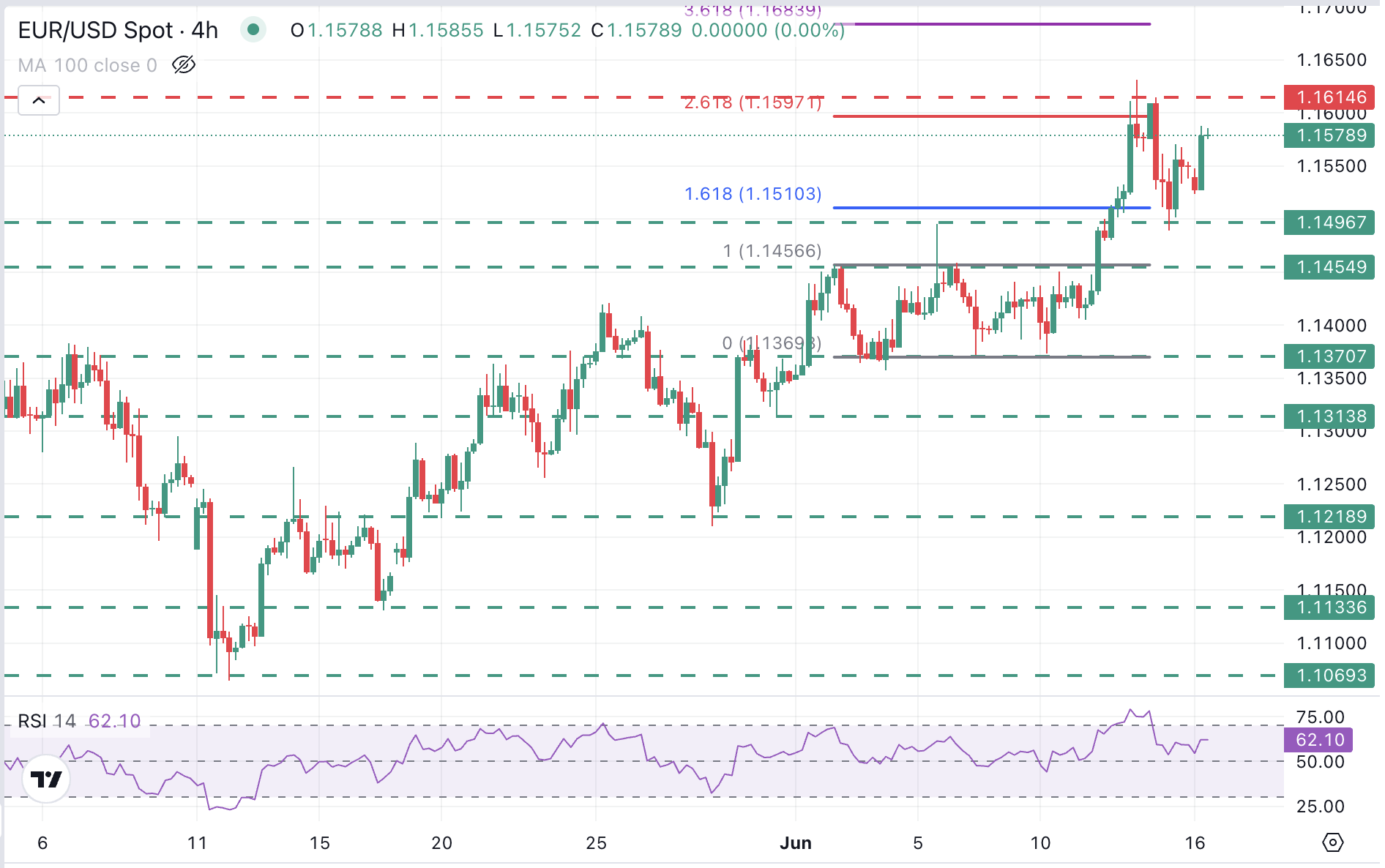- The Euro bounces up with market sentiment improving.
- Fears of escalation in the Middle East conflict have eased.
- EUR/USD maintains its bullish trend intact while above 1.1500.
The EUR/USD pair is trading with moderate advances on Monday, extending its recovery after Friday’s reversal, following Israel’s attack on Iran. The pair has returned to levels above 1.1580 from Friday’s lows at 1.1490 as the market gauges the impact of the Middle East conflict.
Israel and Iran have continued shelling each other over the weekend. Still, so far, the tensions have not spread throughout the region and Iran has not threatened to block the Strait of Hormuz, a strategic path for Oil traffic and whose closure could draw the US into the conflict.
The US Dollar (USD), which rallied on Friday, favoured by investors’ rush for safety, is losing ground again. Tariff uncertainty and the lack of progress on deals between the US administration and its trading partners are resurfacing, weighing on the Greenback, with the clock ticking closer to the July 9 deadline.
Investors are also looking at the Federal Reserve (Fed), which will decide its monetary policy on Wednesday. Interest rates are unlikely to change, but the soft data seen recently might prompt the central bank to show a dovish shift in the tone of its statement, laying the ground for a rate cut in September.
If that is the case, we could see the US Dollar resuming its longer-term bearish trend in the second half of the week.
Euro PRICE Today
The table below shows the percentage change of Euro (EUR) against listed major currencies today. Euro was the strongest against the Swiss Franc.
| USD | EUR | GBP | JPY | CAD | AUD | NZD | CHF | |
|---|---|---|---|---|---|---|---|---|
| USD | -0.38% | -0.18% | -0.26% | -0.11% | -0.39% | -0.25% | 0.04% | |
| EUR | 0.38% | 0.08% | 0.12% | 0.27% | 0.11% | 0.13% | 0.42% | |
| GBP | 0.18% | -0.08% | 0.06% | 0.19% | 0.02% | 0.05% | 0.33% | |
| JPY | 0.26% | -0.12% | -0.06% | 0.13% | -0.45% | -0.37% | -0.13% | |
| CAD | 0.11% | -0.27% | -0.19% | -0.13% | -0.21% | -0.14% | 0.14% | |
| AUD | 0.39% | -0.11% | -0.02% | 0.45% | 0.21% | 0.02% | 0.31% | |
| NZD | 0.25% | -0.13% | -0.05% | 0.37% | 0.14% | -0.02% | 0.28% | |
| CHF | -0.04% | -0.42% | -0.33% | 0.13% | -0.14% | -0.31% | -0.28% |
The heat map shows percentage changes of major currencies against each other. The base currency is picked from the left column, while the quote currency is picked from the top row. For example, if you pick the Euro from the left column and move along the horizontal line to the US Dollar, the percentage change displayed in the box will represent EUR (base)/USD (quote).
Daily digest market movers: The USD retreats as fears of a wider Middle East conflict ease
- The tensions between Israel and Iran extend for their fourth day, but investors are showing some relief at the fact that the conflict has not spread to other countries. Russia and Cyprus have offered themself to mediate in the conflict, and US President Donald Trump urged the countries to find a deal. Risk aversion is ebbing, and the US Dollar is retreating from Friday’s highs.
- As fears about the Middle East war ease, the focus shifts back to the uncertain global trade scenario. A news report released this weekend suggests that the US-China deal might have left the issue of rare earths commerce unresolved, which increases speculation about the real scope and durability of the agreement. The US administration is failing to cut any significant deal with trading partners, except a modest one with the UK and an ambiguous one with China, and the July 9 deadline approaches. So far, this anxiety is harming the US Dollar the most.
- The economic calendar is light in the Eurozone and the US on Monday. The main focus this week will be the Fed’s monetary policy decision, due on Wednesday. The main interest will be on Chairman Jerome Powell’s press release to assess whether the weak macroeconomic data seen in recent weeks has prompted the central bank to consider a rate cut in the near term.
- Futures markets are pricing steady interest rates in June and July, and a 66% chance of an interest rate cut in September, according to data released by the CME Group’s Fed Watch tool.
- In Europe, earlier on Monday, the Bundesbank President and ECB’s council member, Joachim Nagel, remained in a rather neutral territory. He reiterated that the bank should not rush to cut rates further but that the monetary policy committee should remain flexible amid an exceptionally uncertain period.
- Friday’s data revealed that the Eurozone Industrial Production month-over-month contracted at a 2.4% pace in April, well beyond the 1.7% fall expected, in a sign that tariff uncertainty has started to bite into the region’s economy. These figures increased negative pressure on the Euro (EUR).
- In the US, the University of Michigan Consumer Sentiment survey showed improvement, with the index reaching its best preliminary reading in the last four months, at 60.5. Preliminary 1-year Consumer Inflation Expectations, on the other hand, declined to 5.1% in June from 6.6% in May.
Technical analysis: EUR/USD maintains its bullish trend intact while above 1.1495

EUR/USD was rejected at levels above 1.1600 and corrected lower on Friday. Downside attempts, however, have been contained above a previous resistance area, at the 1.1500 area, which keeps the broader bullish structure intact.
The pair is now trading at intra-day highs, with the 4-hour chart RSI moving well above the 50 level, indicating positive momentum. The next resistance is at Friday’s highs in the 1.1615-1.1630 area. Above here, the next target might be the 361.8% Fibonacci extension of the May’s range, at 1.1680
On the downside, the support area is at the June 5 high, at 1.1495, and the 1.1500 psychological level is keeping bulls in control. Below here, the next support is at the 1.1460 area, where the pair was capped on June 2 and 10. Further decline beyond this level would put the bullish trend into question.
Euro FAQs
The Euro is the currency for the 19 European Union countries that belong to the Eurozone. It is the second most heavily traded currency in the world behind the US Dollar. In 2022, it accounted for 31% of all foreign exchange transactions, with an average daily turnover of over $2.2 trillion a day. EUR/USD is the most heavily traded currency pair in the world, accounting for an estimated 30% off all transactions, followed by EUR/JPY (4%), EUR/GBP (3%) and EUR/AUD (2%).
The European Central Bank (ECB) in Frankfurt, Germany, is the reserve bank for the Eurozone. The ECB sets interest rates and manages monetary policy. The ECB’s primary mandate is to maintain price stability, which means either controlling inflation or stimulating growth. Its primary tool is the raising or lowering of interest rates. Relatively high interest rates – or the expectation of higher rates – will usually benefit the Euro and vice versa. The ECB Governing Council makes monetary policy decisions at meetings held eight times a year. Decisions are made by heads of the Eurozone national banks and six permanent members, including the President of the ECB, Christine Lagarde.
Eurozone inflation data, measured by the Harmonized Index of Consumer Prices (HICP), is an important econometric for the Euro. If inflation rises more than expected, especially if above the ECB’s 2% target, it obliges the ECB to raise interest rates to bring it back under control. Relatively high interest rates compared to its counterparts will usually benefit the Euro, as it makes the region more attractive as a place for global investors to park their money.
Data releases gauge the health of the economy and can impact on the Euro. Indicators such as GDP, Manufacturing and Services PMIs, employment, and consumer sentiment surveys can all influence the direction of the single currency. A strong economy is good for the Euro. Not only does it attract more foreign investment but it may encourage the ECB to put up interest rates, which will directly strengthen the Euro. Otherwise, if economic data is weak, the Euro is likely to fall. Economic data for the four largest economies in the euro area (Germany, France, Italy and Spain) are especially significant, as they account for 75% of the Eurozone’s economy.
Another significant data release for the Euro is the Trade Balance. This indicator measures the difference between what a country earns from its exports and what it spends on imports over a given period. If a country produces highly sought after exports then its currency will gain in value purely from the extra demand created from foreign buyers seeking to purchase these goods. Therefore, a positive net Trade Balance strengthens a currency and vice versa for a negative balance.
Information on these pages contains forward-looking statements that involve risks and uncertainties. Markets and instruments profiled on this page are for informational purposes only and should not in any way come across as a recommendation to buy or sell in these assets. You should do your own thorough research before making any investment decisions. FXStreet does not in any way guarantee that this information is free from mistakes, errors, or material misstatements. It also does not guarantee that this information is of a timely nature. Investing in Open Markets involves a great deal of risk, including the loss of all or a portion of your investment, as well as emotional distress. All risks, losses and costs associated with investing, including total loss of principal, are your responsibility. The views and opinions expressed in this article are those of the authors and do not necessarily reflect the official policy or position of FXStreet nor its advertisers. The author will not be held responsible for information that is found at the end of links posted on this page.
If not otherwise explicitly mentioned in the body of the article, at the time of writing, the author has no position in any stock mentioned in this article and no business relationship with any company mentioned. The author has not received compensation for writing this article, other than from FXStreet.
FXStreet and the author do not provide personalized recommendations. The author makes no representations as to the accuracy, completeness, or suitability of this information. FXStreet and the author will not be liable for any errors, omissions or any losses, injuries or damages arising from this information and its display or use. Errors and omissions excepted.
The author and FXStreet are not registered investment advisors and nothing in this article is intended to be investment advice.
Editors’ Picks

EUR/USD grinds higher above 1.1550 despite Middle East conflict
EUR/USD picks up fresh bids and regains 1.1550 in European trading on Monday amid a renewed US Dollar downtick. Despite the fresh USD selling, traders remain wary about the escalating Israel-Iran conflict as the focus remain on the Fed policy decision due on Wednesday.

GBP/USD advances toward 1.3600 as US Dollar loses ground
GBP/USD extends its rebound toward 1.3600 in Monday’s European session, helped by a fresh selling wave around the US Dollar. Markets seem to look past the deepening Middle East conflict, resorting to position adjustments ahead of the Fed and BoE policy announcements later this week.

Gold price consolidates recent strong gains to the highest level since April
Gold price extends its steady intraday retracement slide from a nearly two-month peak and drops to the $3,400 neighborhood during the early European session on Monday. A generally positive tone around the equity markets is seen as a key factor undermining the safe-haven bullion, which now seems to have snapped a three-day winning streak.

The Best brokers to trade EUR/USD
SPONSORED Discover the top brokers for trading EUR/USD in 2025. Our list features brokers with competitive spreads, fast execution, and powerful platforms. Whether you’re a beginner or an expert, find the right partner to navigate the dynamic Forex market.







